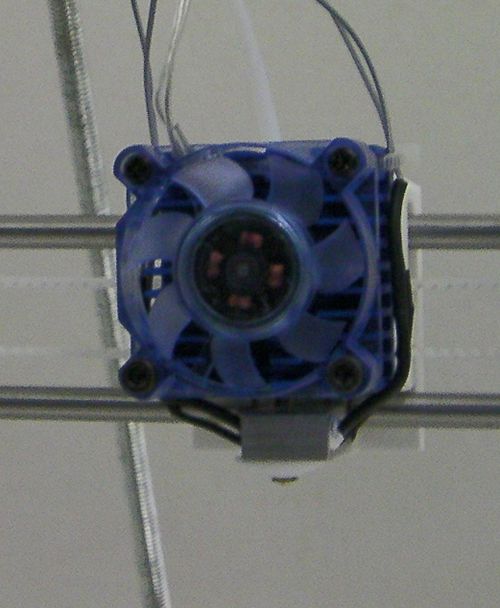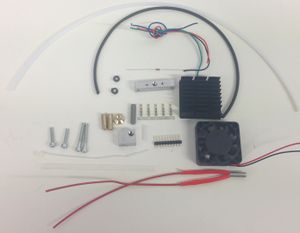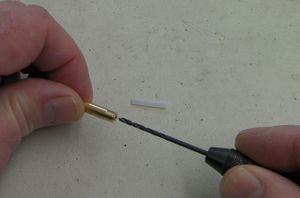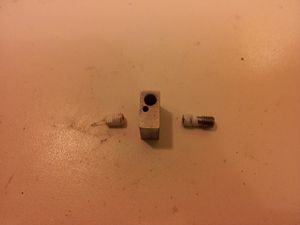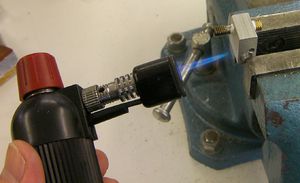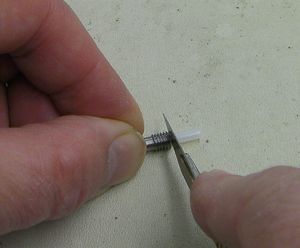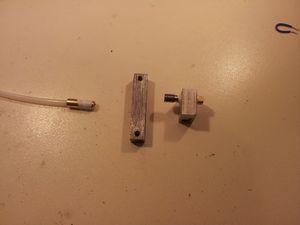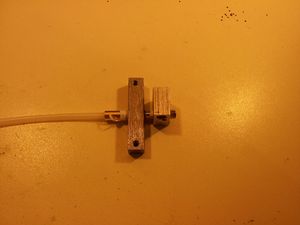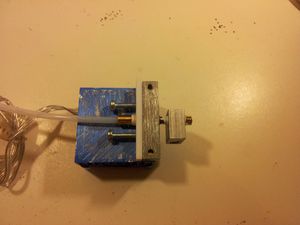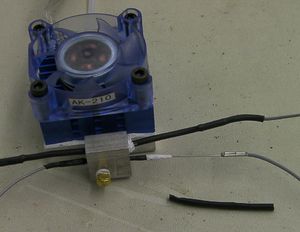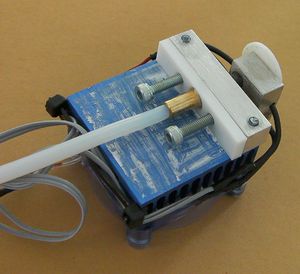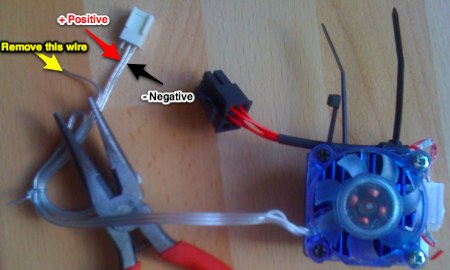RepRapPro Huxley hot end assembly
| Introduction | Frame assembly | Y axis assembly | X axis assembly | Z axis assembly | Heated bed assembly |
| Extruder drive assembly | Hot end assembly | Wiring | Commissioning | Printing | Troubleshooting |
Contents
Goal
By the end of this stage you will have finished all the mechanical construction! Your hot end will be fitted to your Huxley like this:
Tools
You will need the following tools:
- Allen key
- Small screwdriver
- Pliers
- Adjustable spanner
- Heat sources (small blowtorch plus hairdryer/soldering-iron)
- Bench vice
Parts
Sharp eyed readers will notice that the PTFE rectangle with two holes in the loop of wire in the picture is not in the list on the left. It is an old part that may still be in your kit. It is no longer needed.
There are several stages in this construction where you have to trim pieces of PTFE. It is essential to clear any swarf created away and not to let it get into the extruder. PTFE swarf will travel to the nozzle and block it if it is allowed to contaminate the device.
Step 1: The hot part of the hot end
Check that the 6R8 heater resistor fits in the larger hole in the heater block. The resistors can be a little variable in their diameter. If the resistor is too big, clamp the heater block firmly in a vice and run a 5mm drill down it. Be careful to run it square on. Running the drill up and down will shave a little off the sides of the hole. Repeat this until the resistor fits.
Set the resistor aside for use in a minute.
Take the PTFE tube from the extruder drive that you just made. Cut a short length (about 15mm) from its free end using a sharp blade, taking care to make the cut square on to the axis of the tube. Put the short length aside for use later.
Screw the brass union onto the end of the PTFE tube that you have just cut. By looking down the other end of the brass you will be able to see when the PTFE reaches the end of the thread.
Screwing the tube in will have reduced its internal diameter slightly. Gently twist a 2mm drill by hand in the end of the brass to thin the tube where it is inside the screw thread. If you have a small hand-chuck this is made easier:
Push a short length of 1.75mm build filament down the tube from the other end to clear out any PTFE swarf (see the warning above about leaving any behind).
Wrap plumber's PTFE tape round the shorter thread of the stainless steel barrel and the nozzle:
Take care that the tape does not cover the holes, and leave the smooth part of the barrel free (or trim the tape away from that with a blade after wrapping). The barrel has a big temperature drop in operation from one end to the other (around 200oC), so it is important that you leave the middle surface free to radiate heat.
Screw the barrel and the nozzle into the heater block so they meet in the middle. The nozzle goes in the side of the aluminium block with the small 2mm through-hole (that will later accommodate the temperature-measuring thermistor).
Offer up the PTFE insulating cone beside the nozzle. The nozzle should stick out of the block a bigger distance than the depth of the cone. The cone will be screwed onto the nozzle later, and the nozzle needs to project out the bottom.
Place the assembly in the corner of a vice, gripping as little of it as is compatible with its being secure. Adjust the adjustable spanner to the flats on the nozzle and have the long-nosed pliers to hand.
Use the blowtorch to heat the block:
You need to heat the block enough for it to expand by at least the amount it will expand during printing. Neither the brass nozzle nor the stainless steel barrel will expand as much as the aluminium heater block. So, whilst hot, hold the steel coupling with the pliers and tighten the nozzle with the spanner. This will normally take only a very small amount of rotation (say 1 or 2 degress) but will be enough to ensure the nozzle assembly does not leak during printing.
Leave the block in the vice to cool.
Step 2: The cooling system
Take the short length of PTFE tube you saved and put it in the counterbored hole in the stainless steel barrel. Trim it flush with a sharp blade:
Take a 5mm drill and gently twist it against the end of the PTFE that you have just created to dish it slightly. Make sure you clear all swarf away.
Now screw the brass bowden end piece (with the PTFE bowden tube screwed into it), into the Aluminium heatsink block (the long thin one with five holes in it). Once fully screwed in, screw the free end of the barrel into the M5 hole in the Aluminium heatsink block until it meets the brass piece. Now unscrew the brass piece by 1/4 turn, screw the barrel in to meet it, and finally tighten the brass piece with some pliers. This will result in the barrel and bowden end pieces being locked together inside the heatsink block.
The heater block should be parallel with the heatsink block (and with the power resistor).
Peel the sticky backing off the fan and heatsink. This is quite tough - you may need to pull with pliers. Take care not to put stress on the delicate plastic fan.
Keep the sticky backing - you will need it on the next page. Cover the side that was against the fan with polythene (such as the zip bags that the components come in are made from) and keep the plastic covering on the other side.
You can put a little heatsink grease on the aluminium cooling block if you like. Attach it to the fan with the two longer screws. Put the two shorter screws through the PTFE spacer and screw them a few turns into the block.
Step 3: The heater resistor and temperature-measuring thermistor
Try the 6R8 resistor in the hole in the heater block. If the resistor is too lose, wrap it in a little PTFE tape.
Bare about 10mm on the end of two connector wires and crimp them onto the ends of the resistor's leads. Put heatshrink on and use a soldering iron or hairdryer to shrink it.
The picture shows the left-hand side complete, and the right hand side waiting for the crimp to be slid over the join followed by crimping.
The thermistor should fit in its hole - they are manufactured to a tighter tolerance. It will be a little undersized. But the crimps on the thermistor wires won't fit through the hole, so you have to crimp one wire after the thermistor has been pushed through the block.
Wrap the thermistor in PTFE tape, crimp a wire onto one end only, and shrink heatshrink onto that. The heatshrink should come up to the thermistor, over the PTFE tape that will be on its lead, but must not cover the thermistor itself.
As shown above, push the free end of the thermistor through the block until the thermistor comes out the other side, and repeat the wire connection procedure on the unconnected end.
Bend the wires up the side of the heat sink. Do not pull them tight - they need a little slack to accommodate movement and expansion. Attach them at the top of the heatsink with two cable ties chained together, one of them running through the top slot in the heatsink.
Trim the excess off the cable ties.
Step 4: Installation
You need to cut one wire off the fan. Looking at the picture below, use a red and a black felt-tipped pen to mark the positive and negative fan wires.
Cut the socket off (leaving your marks on the fan side of the cut...), then remove the extraneous wire.
Screw the PTFE insulating cone onto the nozzle.
Use the two free screws in the aluminium cooling block to attach the extruder hot end to the X carriage of your Huxley. The PTFE tube clips into the printed vertical channel in the X carriage.
Put the free end of the PTFE tube back in the extruder drive and re-secure it with the tongue that you undid at the end of the previous page.
The tube runs outside the machine. It does not run between the threaded rods.
By hand run the X carriage to X-motor end of its travel and check that the fan does not strike the extruder motor. If it does, wedge a small spacer between the M6 rod of the frame and the extruder motor mounting block. The cable tie that holds the mounting block should be flexible enough to allow this.
